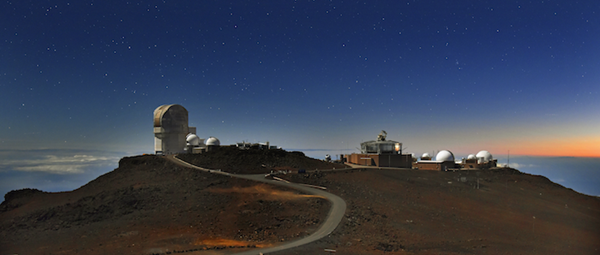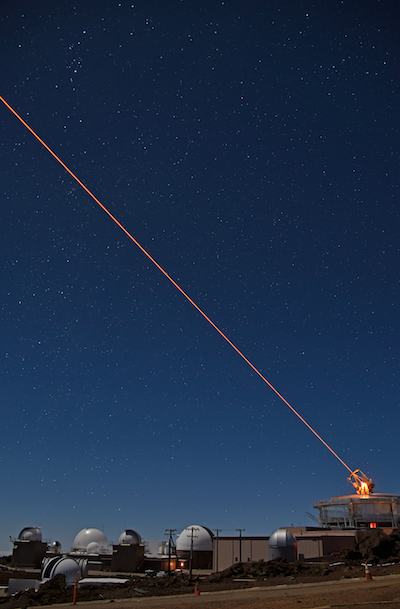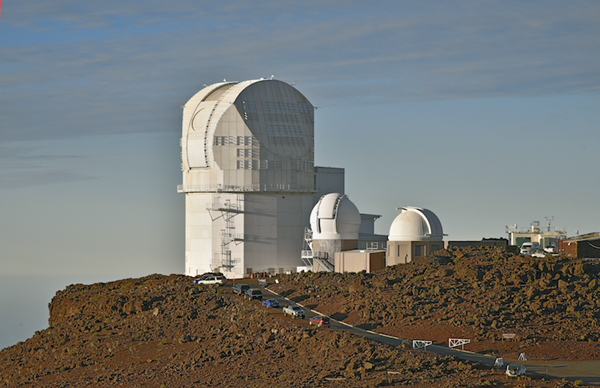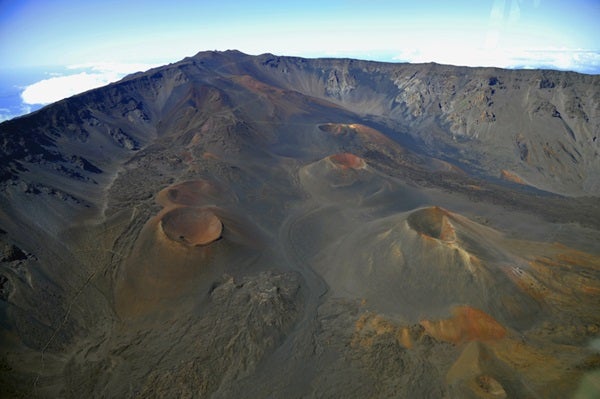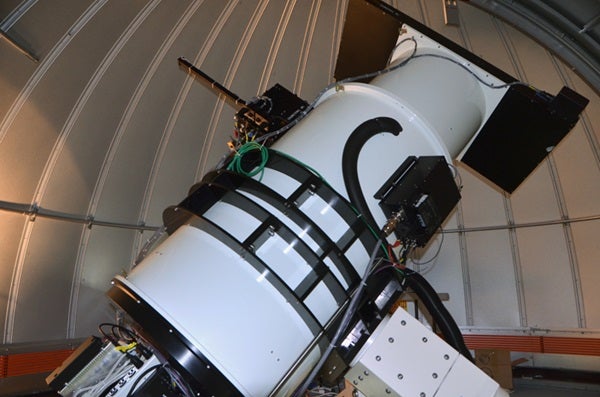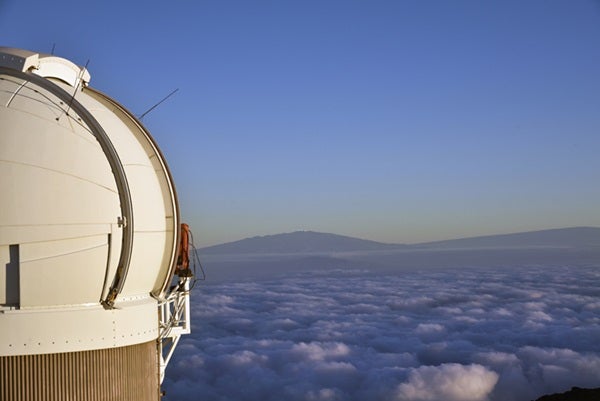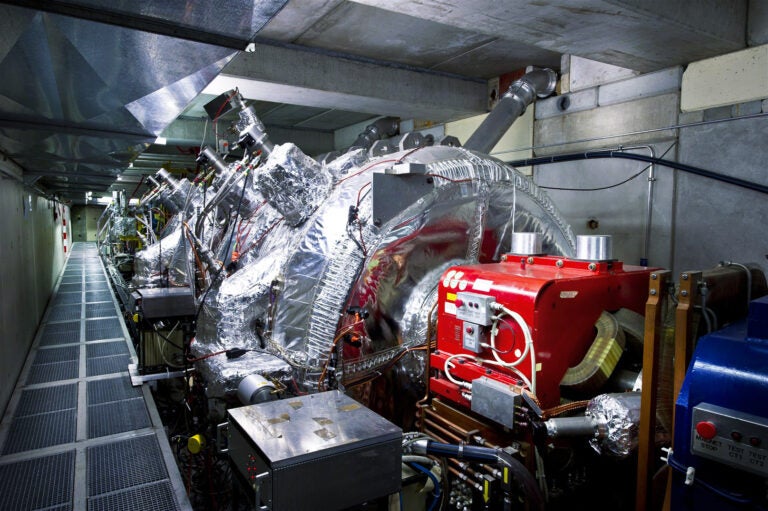Long known as a site for solar observing, Haleakala has more recently gained recognition for two asteroid-spotting survey telescopes, and it is a key site for the Department of Defense in tracking satellites and observing the near-space environment. The arrival of the Daniel K. Inouye Solar Telescope (DKIST), planned to begin operations in 2020, promises to raise Haleakala’s profile even further.
“It’s the best observatory site you’ve never heard of,” says astronomer Robert McLaren, interim director of the University of Hawaii Institute for Astronomy (IfA), which operates the high-tech “Science City” at Haleakala’s summit. As the tallest peak on Maui, the dormant volcano enjoys many of the same advantages of its sister site, he says. Those include its position as a mountaintop surrounded by ocean, which produces smooth airflow for outstanding seeing conditions; a mild climate with clear weather throughout the year; and a location near the equator that gives it a view of both the northern and southern skies.
Even though it’s 3,780 feet (1,152 m) lower than Mauna Kea, Haleakala is a big mountain in its own right. At 10,023 feet (3,055 m), its summit soars above mountaintops that house world-class observatories in the Canary Islands and many of those in Chile.
Yet despite these qualities, Haleakala remains under the radar. “I think even today, if you asked a random astronomer at a conference to name the half-dozen best sites in the world for astronomy, they probably wouldn’t mention Haleakala,” says McLaren. “But they should.”
One reason the site hasn’t received more recognition may be its longtime focus on solar astronomy, he says. “It wasn’t a nighttime astronomy location, and that’s what gets most of the publicity.”
Haleakala was founded as a solar observing site, with the opening of the Mees Solar Observatory in 1964. In fact, the mountain’s name translates to “House of the Sun,” a reference to the myth of Hawaiian demigod Maui, who was said to have stood on the mountain when he lassoed the Sun to slow its progress across the sky and lengthen the day.
Embracing the night
While other telescopes were added to the mountain over the years — including a lunar laser-ranging facility, the 2-meter Faulkes Telescope North operated by Las Cumbres Observatory, and the Defense Department observatories — Haleakala remained known primarily as a solar site.
That changed with the arrival of the Panoramic Survey Telescope and Rapid Response System (Pan-STARRS) in 2010. Equipped with a 1.8-meter telescope and a 1.4-gigapixel camera — still the largest in the world — Pan-STARRS was conceived as a wide-field telescope that would image the entire visible sky several times a month using five broadband filters.
The goal was to create “an enormous catalog of all the objects, with colors, in the northern three-quarters of the sky,” says IfA astronomer Richard Wainscoat, who leads the telescope’s near-Earth object (NEO) program. All things considered, Mauna Kea’s higher elevation would have made it a superior site. When it came time to test Pan-STARRS, however, it was easier to find room on Haleakala, where the project was able to take over two domes that were not in use. “It would have taken many more years to build something new [on Mauna Kea],” says Wainscoat. The prototype ended up working so well that it was kept in use, and a second Pan-STARRS telescope opened on Haleakala in 2014, doubling the program’s observing time.
In December 2016, Pan-STARRS released the largest digital sky survey ever created, a publicly available collection of images cataloging billions of celestial objects. A second data release in January 2019 provided access to every individual exposure.
Today, with most of its funding coming from NASA’s Near-Earth Objects Observation Program, the telescope’s focus has shifted to NEO discovery. “They’re one of the most productive discoverers of near-Earth objects at the present time,” says McLaren. Its discoveries include the so-called “Halloween Asteroid,” a roughly 2,000-foot-wide (600 m) rock that passed relatively close to Earth on October 31, 2015. “It was a reminder that there are a lot of big objects out there still to discover,” he says.
Pan-STARRS isn’t the only asteroid-spotting telescope on Haleakala. The Asteroid Terrestrial-impact Last Alert System (ATLAS) joined it in 2015. This 20-inch (0.5 m) telescope is designed to find small NEOs weeks, days, or even hours before they approach Earth. By combining the telescope on Haleakala with a second one nearly 90 miles (140 kilometers) away on Mauna Loa on the Big Island, ATLAS surveys the entire visible sky every two days.
“We’re not as sensitive as Pan-STARRS, [which is designed to spot far more distant objects], but we cover much more of the sky,” says Larry Denneau, a software engineer with the Research Corporation of the University of Hawaii and co-principal investigator for ATLAS. The coverage and frequency of the survey allows ATLAS to spot fast-moving objects very close to Earth.
Denneau calls Haleakala “an outstanding site.” Telescopes like Keck and Subaru that peer into the most distant parts of the universe benefit from Mauna Kea’s higher elevation, but for wide-field telescopes like ATLAS that don’t need such extreme resolution, Haleakala is fine, he says. “Survey telescopes work well there.”
The arrival of Pan-STARRS — with its magnificent sky survey and discovery of ‘Oumuamua — put Haleakala on the map, says McLaren. “It made a huge impact, first on astronomy, and then on the visibility of Haleakala in terms of [being] a productive astronomical site.” Now, another new facility is poised to elevate Haleakala’s status even more — this time, by taking it back to its roots in daytime astronomy.
Planned since the 1990s, DKIST was conceived to be the biggest solar telescope in the world, one that would be able to investigate some of the Sun’s deepest mysteries. Its design fulfills that vision, says project director Thomas Rimmele. With a 4-meter mirror, DKIST will be more than twice the size of the largest solar telescopes now in existence. At the same time, its off-axis design minimizes scattered light, a critical capability in observing the Sun’s corona. “Solar astronomers have been looking for a large-aperture telescope for a long time,” says Rimmele. “This has been our goal for decades.”
The telescope’s size and sensitivity will give it the ability to observe the Sun in unprecedented detail, including its surface, corona, and the structures of its magnetic fields. While the largest solar telescopes today can study the Sun’s surface at a resolution of about 60 miles (100 km), DKIST will be able to zoom in as tight as 15 miles (25 km), says Rimmele. That level of detail can allow scientists to observe phenomena like sunspots and solar flares as they form. “It’s not just that it’s orders of magnitude more powerful than what we already have,” he says, “it’s the fact that we’ll have the resolution to see what we need to see.”
DKIST is “a really unique telescope at a really unique site,” says Jeff Kuhn, a solar physicist with the IfA who helped start the project as a scientist with the National Solar Observatory (NSO), and is now principal investigator on one of the telescope’s five instruments. The NSO studied dozens of sites, including the Canary Islands and Big Bear, California, and determined Haleakala to be the best location in the world for the telescope, he says.
Contractors completed construction on the exterior of the National Science Foundation-funded $344 million telescope in 2016 and installed the mirror in 2018. Scientists and engineers are currently integrating the telescope’s subsystems, and the project is on track to see first light this year, with all five instruments fully operational by 2020, says Rimmele.
To prepare for the arrival of DKIST, which will be the NSO’s largest program once it begins operations, construction is also underway on new NSO offices in Pukalani, a town in the foothills of Haleakala about 90 minutes from the summit. The building will be next to the IfA’s Maui offices, and eventually it will house 35 to 40 NSO staff members, says Rimmele.
At 13 stories, DKIST is the tallest building on Haleakala, towering over the other telescopes on the summit. Unlike Mauna Kea, where telescopes are in a 525-acre area within an 11,200-acre reserve, Haleakala’s “Science City” is packed into an 18-acre parcel owned by the university. That makes for close quarters at the summit, says Wainscoat, who notes that when DKIST went up, it blocked part of Pan-STARRS’ view of the southern sky. That required the survey telescope to adjust its viewing schedule.
Rimmele agrees that space on the summit is at a premium, and he says DKIST worked closely with the other telescopes on Haleakala to address potential impacts. This included designing the cooling system to minimize the amount of heat exhaust DKIST would release. “You continuously work with the neighbors and come to an agreement on what impacts are acceptable to everybody,” he says. “That’s all part of the process of selecting and locating a site for a telescope.”
DKIST’s size and impact didn’t present an issue just for the astronomy community. It also generated significant controversy among Native Hawaiian and environmental groups in the islands. Although activists on Maui never matched the scale of protests against the Thirty Meter Telescope on Mauna Kea, they made several attempts to block delivery of parts to Haleakala’s summit, calling attention to their opposition to the project.
Mountain peaks are considered especially sacred in Native Hawaiian culture, in which religion and spirituality are tied closely to the land. Opponents said DKIST, along with other construction on Haleakala, was a painful reminder of the theft of Hawaiian lands by Western colonizers, and symbolized the lack of respect shown to Hawaiian cultural sites. “It’s a symbol of oppression that you can see physically in our most sacred space,” says Kaleikoa Kaeo, a Hawaiian-language educator at the University of Hawaii, Maui College, who was arrested while leading a DKIST protest in 2017. “Our people have never given consent to the taking control of Mauna Kea, taking control of Haleakala. It’s really about our fight to determine for ourselves, and control for ourselves, our sacred spaces.”
Rimmele notes that DKIST has worked with members of the Hawaiian community to address their concerns. These efforts include providing a shelter for cultural practitioners preparing for ceremonies at a nearby shrine, minimizing noise pollution, requiring employees to undergo cultural training before working on Haleakala, forming a working group to gather input from Native Hawaiian leaders, and establishing a $20 million fund at the University of Hawaii, Maui College, for a program that combines STEM education with Hawaiian cultural knowledge.
McLaren also acknowledges the opposition and says the university has tried to work with Maui residents to address their concerns. “There’s always been a segment within the local community that would really prefer that there wasn’t any astronomy on the mountains. Partly for aesthetic reasons, partly for cultural reasons, they’d prefer the mountains be left undisturbed,” he says. “Recently, it’s been more intense on Mauna Kea, and to a certain extent on Haleakala.”
An increasingly difficult political climate, combined with tight constraints on space, means that any future development on Haleakala will replace or repurpose an existing facility, McLaren says. “There’s no thought at all of any major new facility,” he says. “There’s simply not room, and we’ve got plenty of activity there.”
The larger scientific community may have yet to discover Haleakala, but for the scientists who work there, it has long been a special place. Kuhn recalls the first time he visited the summit, on a guided tour by the IfA, which was hoping to recruit him away from his position at Michigan State University. “It was one of those sparkling, clear days. There’s this magic moment of driving through the clouds, getting above the clouds, seeing this perfectly clear sky, dark blue, darker than anything you can see from the ground, and this mountain summit. It was enthralling,” he recalls. “It’s the reason I left Michigan.”
In addition to spending time at the summit while he was setting up ATLAS, Denneau has made many camping trips into Haleakala Crater with his son’s Boy Scout troop. The vast crater, which sits just below the summit, is approximately 7.5 miles (12 km) long and 2.5 miles (4 km) wide. “It’s an amazing experience,” he says. “You have parts that are a moonscape, and other parts that are lush meadows, and the clouds are always rolling in.” At night, without any artificial light, Denneau recalls standing outside the cabin with a “cheapo point-and-shoot camera” to snap photos of a sky brilliant with stars. “That’s how amazing the site is,” he says. “It’s a magical place. There’s nothing like it.”

